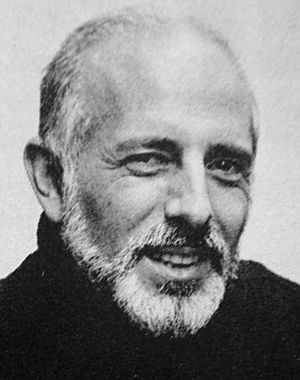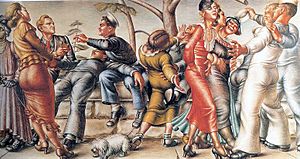Jerome Robbins facts for kids
Quick facts for kids
Jerome Robbins
|
|
|---|---|

Robbins at a photo shoot in 1968
|
|
| Born |
Jerome Wilson Rabinowitz
October 11, 1918 New York City, U.S.
|
| Died | July 29, 1998 (aged 79) New York City, U.S.
|
| Occupation |
|
| Years active | 1937–1998 |
| Awards | Full list |
Jerome Robbins (born Jerome Wilson Rabinowitz; October 11, 1918 – July 29, 1998) was an American dancer, choreographer, and director. He worked in many areas of entertainment, including classical ballet, Broadway shows, films, and television.
Robbins created many famous stage productions. These include On the Town, Peter Pan, The King and I, West Side Story, and Fiddler on the Roof. He won five Tony Awards for his work on Broadway. He also received two Academy Awards for the film West Side Story. One award was for directing, and the other was a special award for his amazing dance work in films.
A documentary about his life, called Something to Dance About, came out in 2009. It showed parts of his journals and old performance videos. This film won an Emmy and a Peabody Award.
Contents
Early Life and Dance Beginnings
Jerome Robbins was born Jerome Wilson Rabinowitz in New York City on October 11, 1918. His family later moved to Weehawken, New Jersey. His father and uncle started a company there. In the 1940s, his family legally changed their last name to Robbins.
Jerome started learning modern dance in high school. His teacher encouraged him to create his own dance moves. After high school, he studied chemistry at New York University (NYU). But he left after a year to focus on dance full-time. He joined a modern dance company and also took ballet, Spanish, and Asian dance classes.
Career Highlights
Starting on Broadway and in Ballet (1930s-1940s)
In 1937, Robbins began dancing in Broadway shows. He also started creating dances for summer revues. One of his early dances was Strange Fruit, set to the famous song sung by Billie Holiday.
In 1940, Robbins joined Ballet Theatre, which is now called American Ballet Theatre. He became a main dancer there. He was known for his roles in ballets like Petrouchka and Romeo and Juliet.
In 1944, Robbins created his first ballet, Fancy Free. It was a funny story about sailors on leave. He got the idea partly from a painting called The Fleet's In!. He asked Leonard Bernstein, who was not very well known then, to write the music.
Later that year, Robbins helped create the musical On the Town, which was based on Fancy Free. This show helped start his Broadway career. Robbins insisted that the dancers in On the Town should be from different backgrounds. This helped break down racial barriers on Broadway. In 1947, he won his first Tony Award for the dances in High Button Shoes. In 1949, he joined the New York City Ballet as an Associate Artistic Director.
Major Successes (1950s)
In the 1950s, Robbins continued to shine as a dancer and choreographer at the New York City Ballet. He also worked on many Broadway shows. He created the famous "Small House of Uncle Thomas" ballet in Rodgers and Hammerstein's The King and I.
He also helped fix problems in musicals that were not doing well. This was called "show doctoring." He worked on shows like A Tree Grows in Brooklyn and Wonderful Town.
In 1954, Robbins co-directed The Pajama Game. He also created, choreographed, and directed Peter Pan, starring Mary Martin. He later restaged Peter Pan for a TV special, which won an Emmy Award.
In 1957, Robbins created, choreographed, and directed West Side Story. This musical was a modern version of Romeo and Juliet. It was set in New York City and featured music by Leonard Bernstein and lyrics by Stephen Sondheim. Robbins made sure the actors could sing, dance, and act equally well. To help the young cast, he kept the actors playing rival gangs (Jets and Sharks) separate during rehearsals. This helped them feel like real rivals. West Side Story earned Robbins his second Tony Award for choreography.
He continued his success with Gypsy in 1959, starring Ethel Merman.
Film and Broadway Triumphs (1960s)
In 1960, Robbins co-directed the film version of West Side Story. The movie won 10 Academy Awards. Robbins himself won two, one for directing and a special award for his amazing dance work in the film.
Robbins was still in high demand to help fix troubled shows. In 1962, he helped save A Funny Thing Happened on the Way to the Forum. He created a new opening song, "Comedy Tonight," which made the show a success. In 1964, he helped turn Funny Girl into a hit, making Barbra Streisand a superstar.
That same year, Robbins won more Tony Awards for directing and choreographing Fiddler on the Roof. This musical, about Jewish life in Russia, became one of Broadway's longest-running shows.
Later Career (1970s-1990s)
Robbins spent most of the 1970s working on classical dance. He became a ballet master at the New York City Ballet in 1972. He only took breaks to restage West Side Story (1980) and Fiddler on the Roof (1981).
In the 1980s, his work was shown more on TV. In 1989, he created Jerome Robbins' Broadway, a show that brought back the best dance numbers from his long career. He won his fifth Tony Award for this show.
After some health issues in the 1990s, Robbins staged Les Noces for City Ballet in 1998. This was his last project.
Death
Jerome Robbins passed away on July 29, 1998, in New York City, after having a stroke. On the night he died, the lights of Broadway were dimmed to honor him.
Awards
Jerome Robbins received many important awards throughout his career:
- He shared the Academy Award for Best Director for the film West Side Story (1961).
- He also received a special Academy Honorary Award for his amazing dance work in films.
- He won five Tony Awards for his work on Broadway.
- He received the Kennedy Center Honors in 1981.
- He was given the National Medal of Arts in 1988.
- He also received the French Legion of Honor.
Jerome Robbins was inducted into the American Theater Hall of Fame in 1979. He was also inducted into the National Museum of Dance's Hall of Fame in 1989.
Jerome Robbins Award
In 1995, Jerome Robbins created a special award to honor great artists or art groups. The first two Jerome Robbins Awards were given in 2003 to the New York City Ballet and to lighting designer Jennifer Tipton.
Broadway Productions and Notable Ballets
- 1939 Stars in Your Eyes – performer
- 1944 On the Town – choreographer and idea creator
- 1945 Interplay – ballet – choreographer and dancer
- 1947 High Button Shoes – musical – choreographer – Tony Award for Best Choreography
- 1948 Look, Ma, I'm Dancin'! – musical – choreographer, co-director, and idea creator
- 1951 The King and I – musical – choreographer
- 1951 The Cage – ballet – choreographer
- 1954 The Pajama Game – musical – co-director
- 1954 Peter Pan – musical – director and choreographer
- 1956 The Concert (or the Perils of Everybody) – ballet – choreographer
- 1957 West Side Story – musical – choreographer, director – Tony Award for Best Choreography
- 1959 Gypsy – musical – choreographer and director
- 1964 Fiddler on the Roof – musical – director and choreographer – Tony Award for Best Direction of a Musical, and Best Choreography
- 1969 Dances at a Gathering – ballet – choreographer
- 1970 In the Night – ballet – choreographer
- 1989 Jerome Robbins' Broadway – revue – director and choreographer – Tony Award for Best Direction of a Musical
Images for kids
See also
 In Spanish: Jerome Robbins para niños
In Spanish: Jerome Robbins para niños









